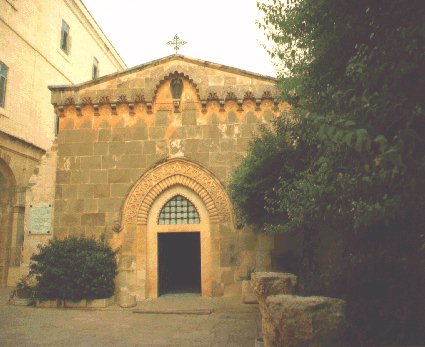 |
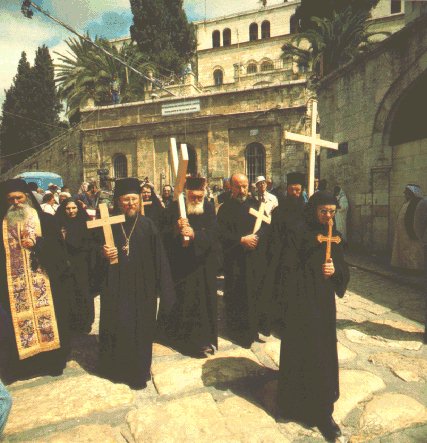 |
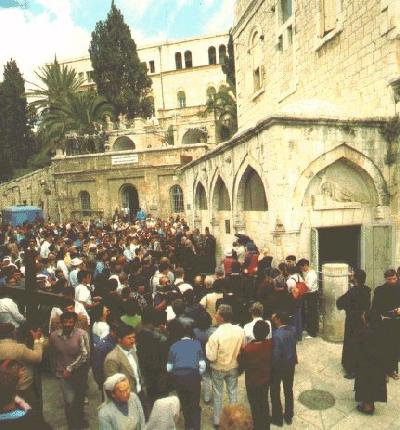 |
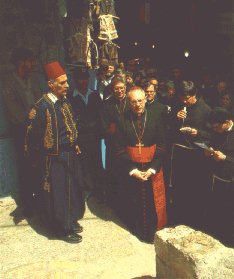 |
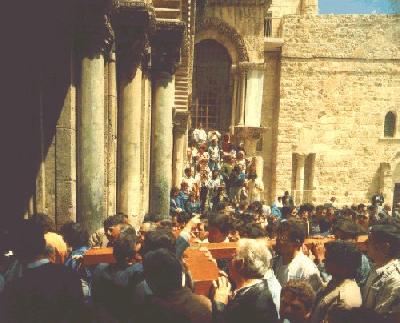 |
 |
 |
 |
 |
 |
Note: Image number will appear in the pop-up line when you will point your mouse on the pictures of Jerusalem. The image number corresponds to the notes number below
By the Via Dolorosa (literally, The Way of Suffering) we mean the road passed by our Saviour from Praetorium to Calvary. The scene of what happened through this road are fixed in 14 stations.
181 = The Church of the Scourging
182.183= Bearing the Cross in Jesus's steps shows special
devotion
184.185 = The Way of the Cross
The Way Of The Sorrows
Forteen sites along the road known as Via Dolorosa "The
Way Of The Sorrows" have been marked as the Stations of the Cross.
These stations (marked by rome numbers I to XIV on the map; see map
page ) commemorate the day when the Son of God went to be crucified.
The road begins at the Church of the Flagellation and ends within the Church
of The Holy Sepulchre. All along the way the Stations are honored on this
route, monuted at intervals on church walls or placed in outdoor shrines.
All Stations of the Cross can be seen with tour groups, or on your own
with guide book or map. Or you can join the Franciscan Friars' processions
(often complete with carried cross) Fridays at 3pm starting at Station
I.
The first ( I ) station: The Praetorium where Jesus was condemned to death. It is located in the courtyard of Al Omariyeh College. This is where Pilate sat in judgement and condemned Jesus to death on the cross (St. John 19:13).
The second ( II ) station is marked by a board across from Omariyeh College, signifiying where Jesus took up the Cross. To the right of the station is the Chapel of Flagellation where Jesus was scouraged by Roman soldiers.
The third ( III ) station, where Via Dolorosa intersects with El Wad, is where (Jesus first fell while carrying the cross. A small polish chapel built in 1947 marks the spot with a relief in the arch above the lintel showing Jesus falling under the weight of the cross.
The fourth ( IV ) station is just past the Hospice. It is where Jesus saw his mother in the crowd. This event is commemorated by the Chapel of the Swooning Virgin (built around 1950) and the Armenian Catholic Church of the Virgin Mary's Sorrows (built 1881).
The fifth ( V ) station requires a right turn on Via Dolorosa to where Simon the Cyrene (from modern day Libya) helped Jesus carry the cross. A Franciscan chapel built in 1881 with signs on the door mark the spot.
The sixth ( VI ) station is fifty meters away from the fifth station. It is where Veronica wiped the face of Jesus with her cloth. The holy relic of the cloth, complete with imprint of Jesus face, is revered by the catholic Church; it is on display at the Greek Orthodox Patriarchate in the Christian Quarter.
The seventh ( VII ) station is for Jesus second fall. It is honored by a Fransciscan chapel built in 1875 and by signs on the wall west of Shuk khan ex-Zeit. In the first century this marked the edge of the city with a gate (see Jesus time Jerusalem map at the maps page), a fact used to substantiate the argumant that the Church of the Holy Sepulcher is the true location of Jesus crucifixion.
The eighth ( VIII ) station represents where Jesus said to the lamenting women "Weep not for me, but weep for yourselves, and for your children..." (St.Luke 23: 28-30). This spot is difficult one to find. Cross Khan ez-Zeit and ascend Aqabatel-Khanqa. Just past the Greek Orthodox Convent on the left is the stone with a cross and the insciption IC XC NIKA (Jesus Christ is victorious) to mark the Station.
The nineth ( IX ) station: is where Jesus fell for a third time. The are remains of a pillar back on Khan az-Zeit marking this station.
The remaining stations ( X-XIV ) are all in the Church of Holy Sepulcher.
The tenth ( X ) station: For the 10th Station, enter the church and climb the steep stairway on your right. The chappel has two naves, and the entrance to the one on the right, the Franciscan one, is where Jesus had his clothes stripped from his body. At the far end of this same chapel is the 11th Station.
The eleventh ( XI ) station: It is where Jesus was nailed to the Cross.
The twelfth ( XII ) station is where Jesus was crucified and died on the Cross. To mark the spot there hangs of a life sized Jesus amid flowers and the flames of oil lamps and candles.
The thirteenth ( XIII ) station: The body of Jesus taken dowm from the Cross and received by Mary, as commemorated by a statue of a bejeweled Mary with a silver dagger stuck in her breast.
The fourteenth ( XIV ) station is down in the Holy Sepulcher. It is where Jesus was buried and where he rose again.
Drs.Koudinov Office
|| Drs.Koudinov Holy Land || step
back || continue the tour || Jerusalem
and Holy Land maps
To stop audio press STOP button on the Internet Explorer toolbar